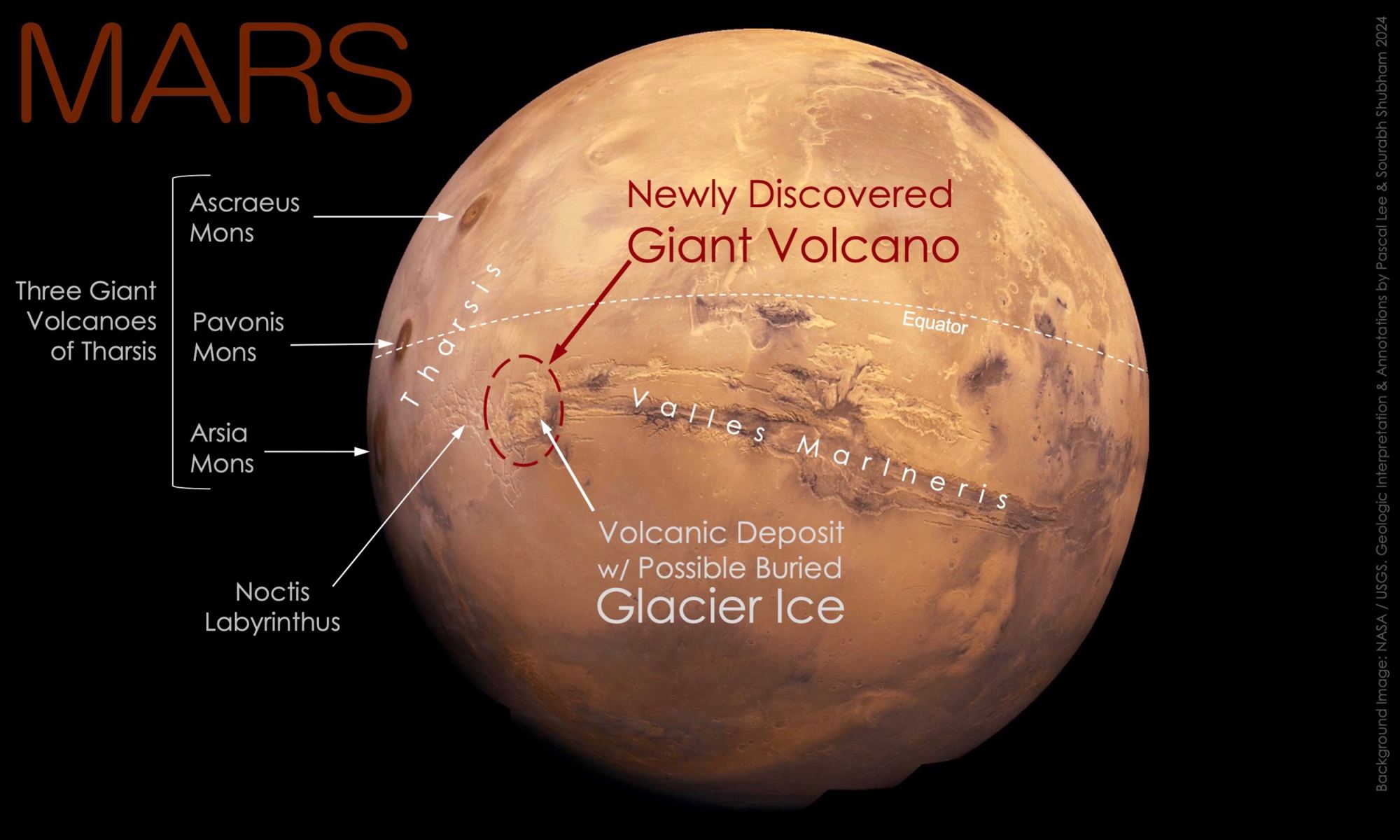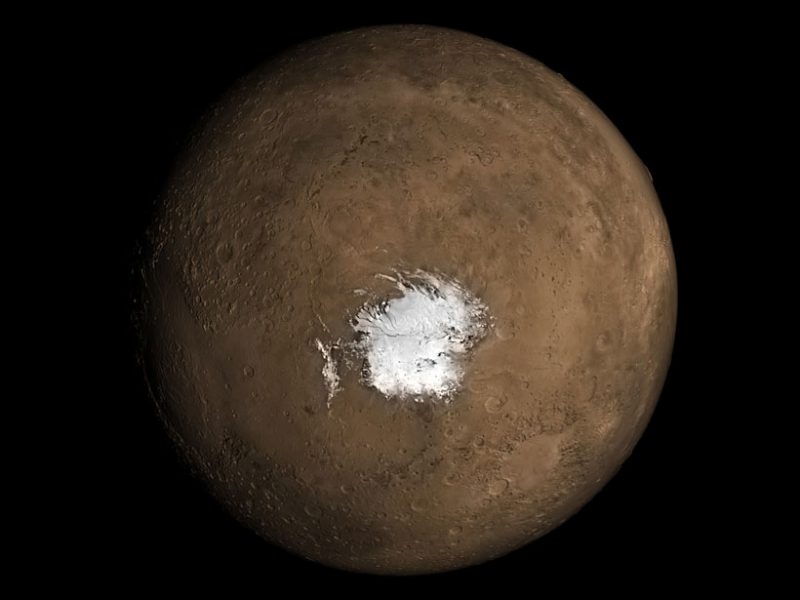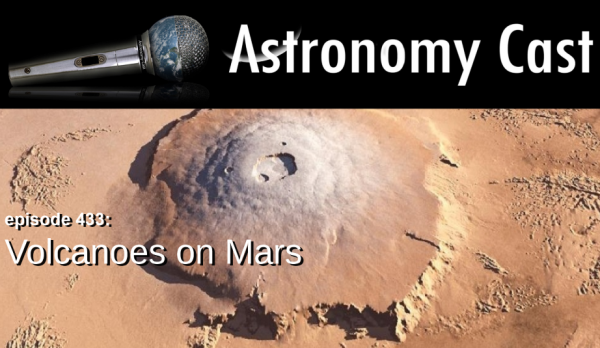Olympus Mons is well known for being the largest volcano in the Solar System. It’s joined on Mars by three other shield volcanoes; Ascraeus, Pavonis and Arsia but a recent discovery has revealed a fifth. Provisionally called Noctis volcano, this previously unknown Martian feature reaches 9,022 metres high and 450 kilometres across. Its presence has eluded planetary scientists because it has been heavily eroded and is on the boundary of the fractured maze-like terrain of Noctis Labyrinthus.
Continue reading “Mars Was Hiding Another Giant Volcano”There’s Evidence that Mars is Still Volcanically Active
A new study shows that Mars may very well be volcanically active. Nobody’s seen direct evidence of volcanism; no eruptions or magma or anything like that. Rather, the proof is in the water.
Continue reading “There’s Evidence that Mars is Still Volcanically Active”This Meteorite Came From a Volcano on Mars
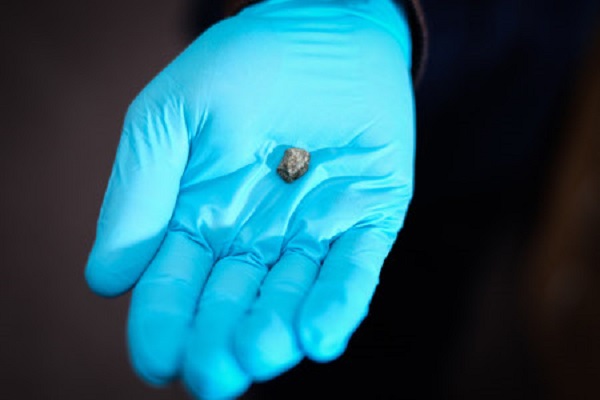
Today, it is well understood that Mars is a cold, dry, and geologically dead planet. However, billions of years ago when it was still young, the planet boasted a denser atmosphere and had liquid water on its surface. Millions of years ago, it also experienced a significant amount of volcanic activity, which resulted in the formation of it’s massive features – like Olympus Mons, the largest volcano in the Solar System.
Until recently, scientists have understood that Martian volcanic activity has been driven by sources other than tectonic movement, which the planet has been devoid of for billions of years. However, after conducting a study of Martian rock samples, a team of researchers from the UK and United States concluded that eons ago, Mars was more volcanically active than previously thought.
Their study, titled “Taking the Pulse of Mars via Dating of a Plume-fed Volcano“, recently appeared in the scientific journal Nature Communications. Led by Benjamin Cohen, a researcher with the Scottish Universities Environmental Research Center (SUERC) and the School of Geographical and Earth Sciences at the University of Glasgow, the team conducted an analysis of Mars’ volcanic past using samples of Martian meteorites.
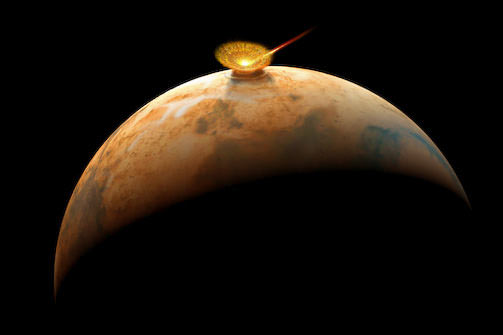
On Earth, the majority of volcanism occurs as a result of plate tectonics, which are driven by convection in the Earth’s mantle. But on Mars, the majority of volcanic activity is the result of mantle plumes, which are highly-localized upwellings of magma that rise from deep within the mantle. This is due to the fact that Mars’ surface has remained static and cool for the past few billion years.
Because of this, Martian volcanoes (though similar in morophology to shield volcanoes on Earth), grow to much larger sizes than those on Earth. Olympus Mons, for example, is not only the largest shield volcano on Mars, but the largest in the Solar System. Whereas the tallest mountain on Earth – Mt. Everest – is 8,848 m (29,029 ft) in height, Olympus Mons stands some 22 km (13.6 mi or 72,000 ft) tall.
For the sake of their study, Dr. Cohen and his colleagues used radioscopic dating techniques, which are commonly used to determine the age and eruption rate of volcanoes on Earth. However, such techniques have not been previously used for shield volcanoes on Mars. As a result, the team’s study of Martian meteorite samples was the first detailed analysis of growth rates in Martian volcanoes.
The six samples they examined are known as nakhlites, a class of Martian meteorite that formed from basaltic magma roughly 1.3 billion years ago. These came to Earth roughly 11 million years ago after being were blasted from the face of Mars by an impact event. By conducting an analysis of Martian meteorites, the team was able to uncover about 90 million years’ worth of new information about Mars’ volcanic past.
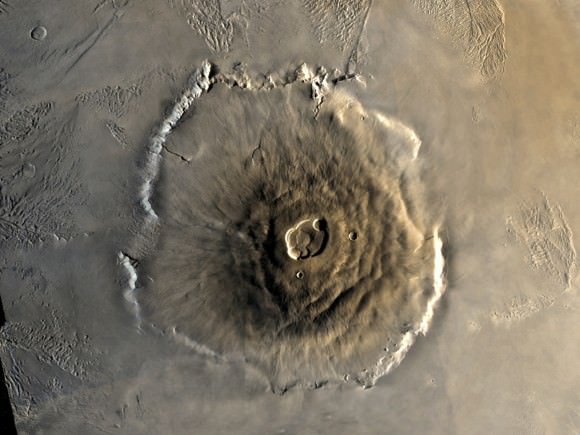
As Dr. Cohen explained in a University of Glasgow press release:
“We know from previous studies that the nakhlite meteorites are volcanic rocks, and the development of age-dating techniques in recent years made the nakhlites perfect candidates to help us learn more about volcanoes on Mars.”
The first step was to demonstrate that the rock samples were indeed Martian in origin, which the team confirmed by measuring their exposure to cosmogenic radiation. From this, they determined that the rocks were expelled from the Martian surface 11 million years ago, most likely as a result of an impact event on the Martian surface. They then applied a high-precision radioscopic technique known as 40Ar/39Ar dating.
This consisted of using a noble gas mass spectromomer to measure the amount of argon built up in the samples, which is the result of the natural radioactive decay of potassium. From this, they were able to obtain 90 million years’ worth of new information about the Martian surface. The results of their analysis indicated that there are significant differences in volcanic history between the Earth and Mars. As Dr. Cohen explained:
“We found that the nakhlites formed from at least four eruptions over the course of 90 million years. This is a very long time for a volcano, and much longer than the duration of terrestrial volcanoes, which are typically only active for a few million years. And this is only scratching the surface of the volcano, as only a very small amount of rock would have been ejected by the impact crater – so the volcano must have been active for much longer.”
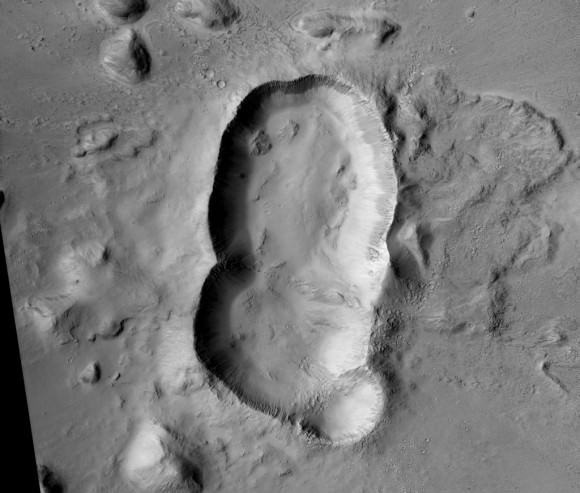
In addition, the team was also able to narrow down which volcanoes their rock samples came from. Previous studies conducted by NASA revealed several candidates for the possible nakhlite source crater. However, only one of the locations matched their results in terms of the age of the volcanic eruptions and the impact that would have ejected the samples into space.
This particular crater (which is currently unnamed) is located in the volcanic plains known as Elysium Planitia, roughly 900 km (560 mi) away from summit of the Elysium Mons volcano – which stands 12.6 km (7.8 mi) tall. It is also located about 2000 km (1243 mi) north of where the NASA Curiosity rover currently is. As Cohen explained, NASA has some wonderfully detailed satellite images of this particular crater.
“It is 6.5 km wide, and has preserved ejecta rays of debris,” he said. “And we were able to see multiple horizontal bands on the crater walls – which indicating the rocks form layers, with each layer interpreted as a separate lava flow. This study has been able to provide a clearer picture into the history of the nakhlite meteorites, and in turn the largest volcanoes in the solar system.”
In the future, sample return and crewed missions to Mars are sure to clear up this picture even further. Given that Mars, like Earth, is a terrestrial planet, knowing all we can about its geological history will ultimately improve our understanding of how the rocky planets of the Solar System formed. In short, the more we know about Mars’ volcanic history, the most we will be able to learn about the Solar System’s formation and evolution.
Further Reading: University of Glasgow, Nature Communications
Ancient Volcanoes on Mars Could Have Been the Place for Life
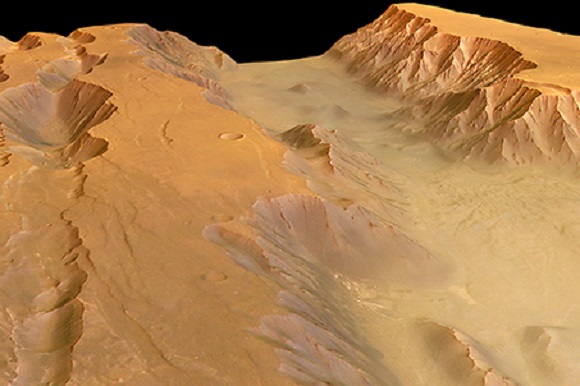
For decades, Mars has been the focal point of intense research. Beginning in the 1960s, literally dozens of robotic spacecraft, orbiters and rovers have explored Mars’ atmosphere and surface, looking for clues to the planet’s past. From this, scientists now know that billions of years ago, Mars was a warmer, wetter place. Not only did liquid water exist on its surface, but it is possible life existed there in some form as well.
Granted, some recent findings have cast some doubt in this, indicating that Mars’ surface may have been hostile to microbes. But a new study from an international team of scientists indicates that evidence life could be found in volcanic deposits. Specifically, they argue that within the massive geological structure known as Valles Marineris, there may be ancient volcanoes that have preserved ancient microbes.
The study, titled “Amazonian Volcanism Inside Valles Marineris on Mars“, recently appeared in the journal Earth and Planetary Science Letters. Led by Petr Brož of the Institute of Geophysics at the Czech Academy of Sciences (AVCR), the team examined Mars’ famous Valles Marineris region – a canyon system stretching for 4000 km (2485.5 mi) – for signs of recent geological activity, which opens up the possibility of there also being fossilized life there.
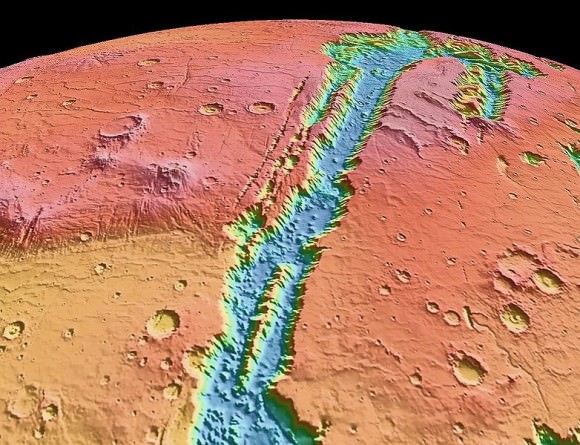
The team began by examining the Coprates Chasma canyon, one of the lowest points in Valles Marineris, which is home to over 130 volcanoes and solidified lava flows. This consisted of analyzing high-resolution images of the region that were taken by NASA’s Mars Reconnaissance Orbiter (MRO), which revealed cones of basaltic lava (aka. scoria) and ash that measured around 400-meters (1300 ft) high.
After examining the cones’ surface patterns and morphological details, they confirmed that these were indeed the remains of lava volcanoes (and not mud volcanoes, which was another possibility). In addition, they also noted similarities between these cone and others on Mars where mud volcanism is not possible – as well as similarities with volcanic cones here on Earth.
As Ernst Hauber, a researcher from the Institute of Planetary Research at the German Aerospace Center (DLR) and a co-author on the study, explained in a AVCR press release:
“The spatial distribution of the cones also suggests their volcanic origin. They appear to occur more frequently along tectonic fractures that formed the trough in the surface and whose fracture interfaces continue into the subsurface, creating pathways for the magma to ascend.”
Even more surprising was the apparent age of the volcanoes, which was very young. On Mars, the main period of volcanic activity ended during Mars’ Hesperian Period – which ran from 3.7 to approximately 3.0 billion years ago. And while images acquired by the Mars Express mission have shown indications of younger volcanoes (occurring 500 million years ago), these tend to be located in volcanic provinces.
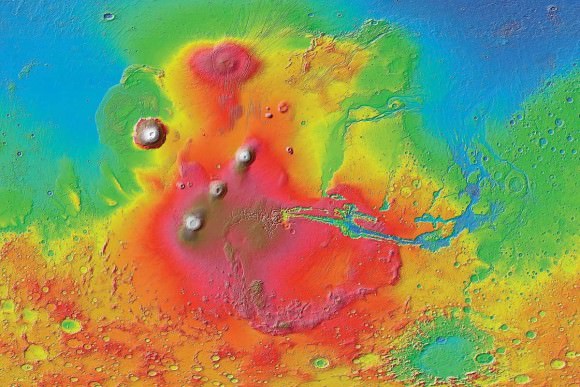
A good example of this is the Tharsis Bulge, which is located several thousand km from the Coprates Chasma canyon. It is here that the Tharses Montes mountain chain is located, which consists of the shield volcanoes of Ascraeus Mons, Pavonis Mons and Arsia Mons. Olympus Mons, the tallest mountain in the Solar System (with an elevation of 22 km or 13.6 mi), is located at the edge of this region.
In contrast, the volcanic cones spotted in the Coprates Chasma canyon were estimates to be between 200 and 400 million years of age, placing them in the most recent geological period known as the Amazonian (3.0 billion years ago to the present day). This effectively demonstrates that these volcanoes formed late in Mars’ history and far away from volcanic areas like Tharsis and Elysium.
It also demonstrates that these volcanoes were not part of the original formation of Valles Marineris, which is believed to be related to the formation of the Tharsis Bulge. This all took place between the Noachian to Late Hesperian periods of Mars (ca. 3.5 billion years ago), which was the last time Mars experienced widespread geological activity.
Last, but not least, the team used the Compact Reconnaissance Imaging Spectrometer (CRISM) aboard the MRO to learn more about the mineral compositions of the region’s lava and volcanic cones. Once again, their findings proved to be surprising, and could indicate that the Coprates Chasma region is a suitable location to search for evidence of ancient life on Mars.
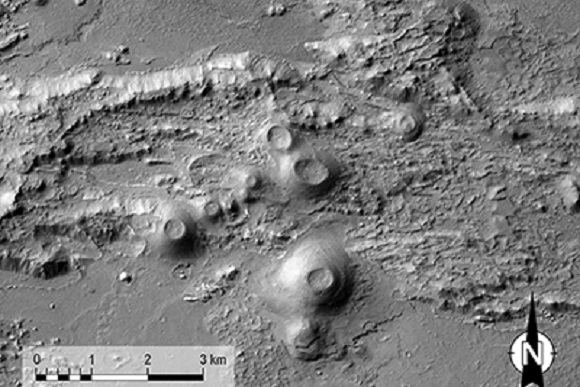
Essentially, the CRISM data indicated the presence of high-silica content minerals in the volcanic rock, which included opaline-like substances at one of the peaks. Opaline silicates, it should be noted, are water-bearing materials that are often produced by hydrothermal processes – where silicate structures form from supersaturated, hot solutions of minerals that cool to become solid.
On Earth, microorganisms are often found within opal deposits since they form in energy and mineral-rich environments, where microbial lifeforms thrive. The presence of these minerals in the Coprates Chasma region could therefore mean that ancient microorganisms once thrived there. Moreover, such organisms could also be fossilized within the mineral-rich lava rock, making it a tempting target for future research.
As Hauber indicated, the appeal of Coprates Chasma doesn’t end there, and future mission will surely want to make exploring this region a priority:
“Coprates Chasma is not just interesting with regard to the question of previous life on Mars. The region would also be an excellent landing site for future Mars Rovers. Here we could investigate many scientifically important and interesting topics. Analyzing samples for their elemental isotopic fractions would allow us to determine with far greater precision when the volcanoes were actually active.
“On the towering, steep walls, the geologic evolution of the Valles Marineris is presented to us almost like a history book – gypsum strata and layers of old, crustal rocks can be observed, as well as indications for liquid water trickling down the slopes even today during the warm season. That is as much Mars geology as you can get!”
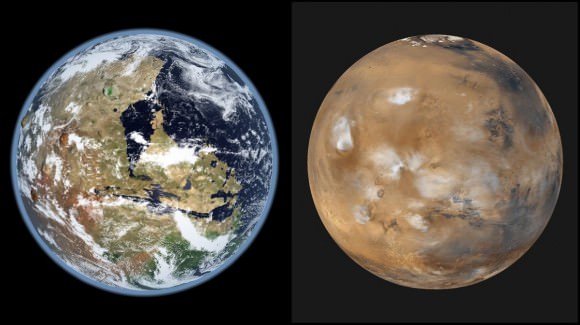
In other words, this low-lying region could be central to future studies that attempt to unlock the history and geological evolution of the Red Planet. The payoffs of studying this region not only include determining if Mars had life in the past, but when and how it went from being a warmer, wetter environment to the cold, dessicated landscape we know today.
In the future, NASA, the ESA, the China National Space Agency (CNSA) and Roscosmos all hope to mount additional robotic missions to Mars. In addition, NASA and even SpaceX hope to send crewed missions to the planet in the hopes of learning more about its past – and possibly future – habitability. Between its geological history, greater atmospheric pressure, and the possibility of fossilized life, one or more of these missions may be headed to Valles Marineris to have a look around.
Further Reading: The Czech Academy of Science, Earth and Planetary Science Letters
Meteorite Confirms 2 Billion Years of Volcanic Activity on Mars
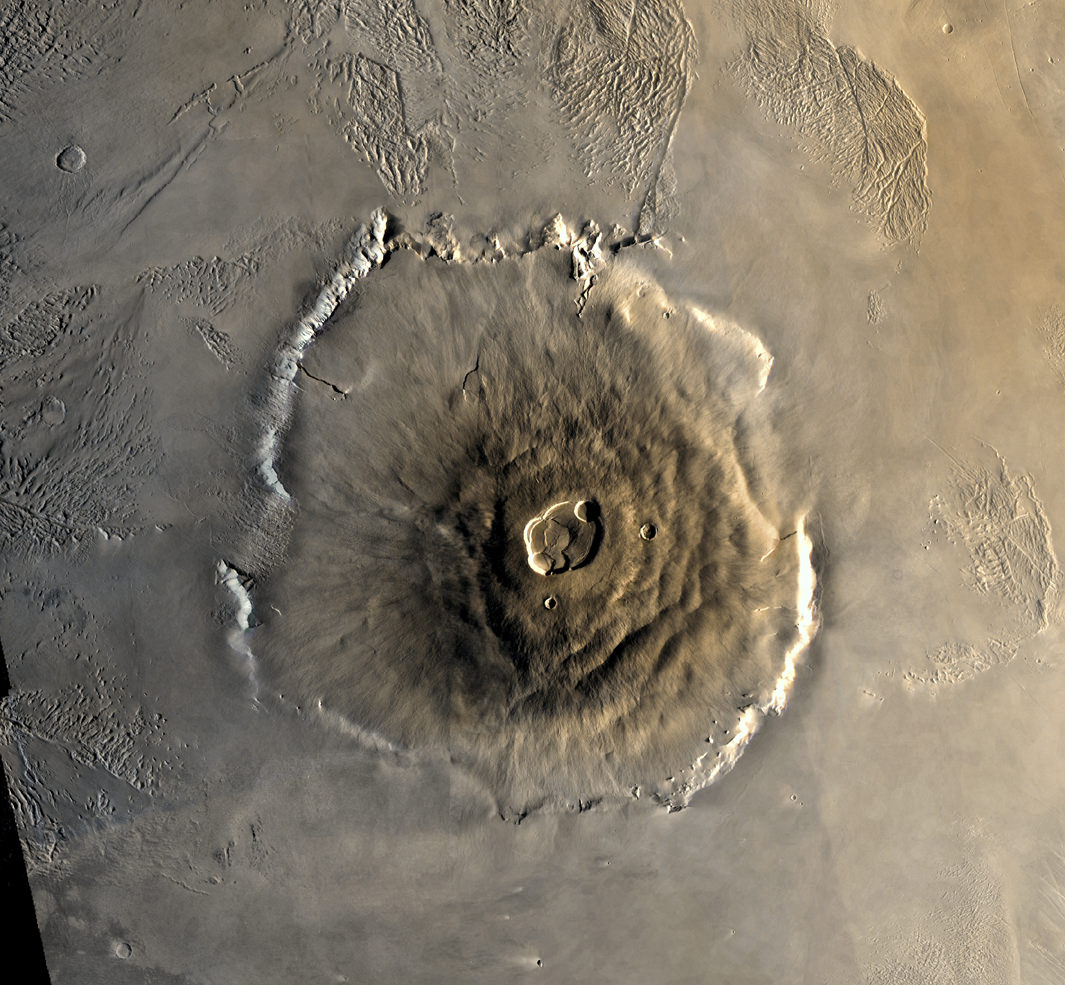
Mars is renowned for having the largest volcano in our Solar System, Olympus Mons. New research shows that Mars also has the most long-lived volcanoes. The study of a Martian meteorite confirms that volcanoes on Mars were active for 2 billion years or longer.
A lot of what we know about the volcanoes on Mars we’ve learned from Martian meteorites that have made it to Earth. The meteorite in this study was found in Algeria in 2012. Dubbed Northwest Africa 7635 (NWA 7635), this meteorite was actually seen travelling through Earth’s atmosphere in July 2011.
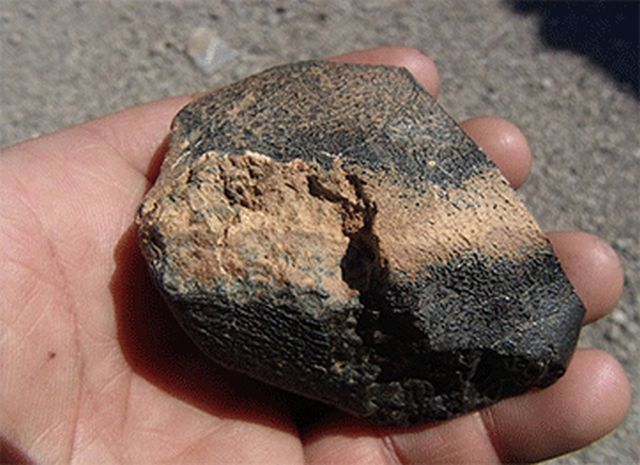
The lead author of this study is Tom Lapen, a Geology Professor at the University of Houston. He says that his findings provide new insights into the evolution of the Red Planet and the history of volcanic activity there. NWA 7635 was compared with 11 other Martian meteorites, of a type called shergottites. Analysis of their chemical composition reveals the length of time they spent in space, how long they’ve been on Earth, their age, and their volcanic source. All 12 of them are from the same volcanic source.
Mars has much weaker gravity than Earth, so when something large enough slams into the Martian surface, pieces of rock are ejected into space. Some of these rocks eventually cross Earth’s path and are captured by gravity. Most burn up, but some make it to the surface of our planet. In the case of NWA 7635 and the other meteorites, they were ejected from Mars about 1 million years ago.
“We see that they came from a similar volcanic source,” Lapen said. “Given that they also have the same ejection time, we can conclude that these come from the same location on Mars.”
Taken together, the meteorites give us a snapshot of one location of the Martian surface. The other meteorites range from 327 million to 600 million years old. But NWA 7635 was formed 2.4 billion years ago. This means that its source was one of the longest lived volcanoes in our entire Solar System.

Volcanic activity on Mars is an important part of understanding the planet, and whether it ever harbored life. It’s possible that so-called super-volcanoes contributed to extinctions here on Earth. The same thing may have happened on Mars. Given the massive size of Olympus Mons, it could very well have been the Martian equivalent of a super-volcano.
The ESA’s Mars Express Orbiter sent back images of Olympus Mons that showed possible lava flows as recently as 2 million years ago. There are also lava flows on Mars that have a very small number of impact craters on them, indicating that they were formed recently. If that is the case, then it’s possible that Martian volcanoes will be visibly active again.

Continuing volcanic activity on Mars is highly speculative, with different researchers arguing for and against it. The relatively crater-free, smooth surfaces of some lava features on Mars could be explained by erosion, or even glaciation. In any case, if there is another eruption on Mars, we would have to be extremely lucky for one of our orbiters to see it.
But you never know.
Astronomy Cast Ep. 433: Volcanoes on Mars
So if you’ve been to Yellowstone National Park, you’ve seen one of the most amazing features of the natural world – geysers. In today’s episode, we’re going to talk about geysers on Earth, and where they might be in the solar system.
Visit the Astronomy Cast Page to subscribe to the audio podcast!
We usually record Astronomy Cast as a live Google+ Hangout on Air every Friday at 1:30 pm Pacific / 4:30 pm Eastern. You can watch here on Universe Today or from the Astronomy Cast Google+ page.

